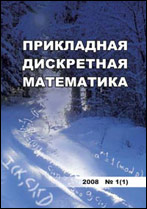|
Mathematical Backgrounds of Informatics and Programming
The generic complexity of the graph triangulation problem
A. N. Rybalov
Sobolev Institute of Mathematics, Omsk, Russia
Abstract:
Generic-case approach to algorithmic problems was suggested by A. Miasnikov, V. Kapovich, P. Schupp, and V. Shpilrain in 2003. This approach studies behavior of an algorithm on typical (almost all) inputs and ignores the rest of inputs. In this paper, we study the generic complexity of the graph triangulation problem. This problem is as follows. Given a finite simple graph with $3n$ vertices, determine whether the vertices of the graph can be divided into $n$ three-element sets, each of which contains vertices connected by edges of the original graph (that is, they are triangles). NP-completeness of this problem was proved by Shaffer in 1974 and is mentioned in the classic monograph by M. Garey and D. Johnson. We prove that under the conditions $\text {P} \neq \text{NP}$ and $\text{P} = \text{BPP}$ there is no polynomial strongly generic algorithm for this problem. A strongly generic algorithm solves a problem not on the whole set of inputs, but on a subset whose frequency sequence converges exponentially to $1$ with increasing size. To prove the theorem, we use the method of generic amplification, which allows one to construct generically hard problems from the problems that are hard in the classical sense. The main component of this method is the cloning technique, which combines the inputs of a problem together into sufficiently large sets of equivalent inputs. Equivalence is understood in the sense that the problem for them is solved in a similar way.
Keywords:
generic complexity, graph triangulation problem.
Citation:
A. N. Rybalov, “The generic complexity of the graph triangulation problem”, Prikl. Diskr. Mat., 2022, no. 58, 105–111
Linking options:
https://www.mathnet.ru/eng/pdm789 https://www.mathnet.ru/eng/pdm/y2022/i4/p105
|

| Statistics & downloads: |
| Abstract page: | 68 | | Full-text PDF : | 29 | | References: | 17 |
|




 Contact us:
Contact us: Terms of Use
Terms of Use
 Registration to the website
Registration to the website Logotypes
Logotypes








 Citation in format
Citation in format 